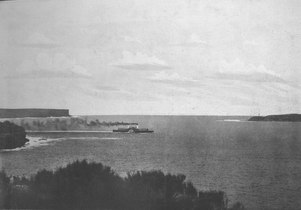PS Brighton
 Brighton at Circular Quay after her wheelhouse was closed in
| |
| History | |
|---|---|
| Name | Brighton |
| Builder | Thomas B. Seath Rutherglen |
| Launched | 15 December 1882[1] |
| Completed | 1883 |
| Identification | O/N 83792 |
| General characteristics | |
| Class and type | Ferry |
| Tonnage | 417 gross register tons |
| Length | 220.2 feet (67.1 m) |
| Beam | 23 feet (7.0 m) |
| Draught | 10.7 feet (3.3 m) |
PS Brighton was a ferry used on the Sydney to Manly run. The biggest Manly ferry at the time and the largest paddle steamer to operate on Sydney Harbour, she was well-appointed and popular with passengers.[2]
Background
In the late 1800s, the Manly to Circular Quay (Sydney) ferry service was growing, and the Port Jackson Steamsboat Company was expanding. In 1878, the double-ended Fairlight was ordered from England and tug-ferry Commodore soon followed.
Following an 1881 name change to Port Jackson Steamship Company, the Brighton was ordered.[3]
Design and construction
The ship was constructed by Thomas B. Seath of Rutherglen, Scotland in 1883.[4] She was said to be a copy of the Primrose and Daisy which ran on the River Mersey, England.[2]
Her paddle wheels were driven by two A. Campbell & Son compound diagonal oscillating steam enginers generating 160 hp and then 230 hp in the 1890s. She could reach a speed of 15 knots. She had a summer capacity of 1,137 passengers - as many as the modern manly ferries - and 885 in winter.[5]
She set out from Scotland for Sydney on 2 June 1883. Near Colombo, large waves crashed over the stern and ran the full length of the decks ripping out fittings including seats. She ran aground on several occasions and lack of wind rendered her auxiliary sails useless on the voyage. Steaming down the Australian coast, the crew had to burn planking and cabin doors to keep a head of steam after almost running out of fuel close to her destination, Sydney. She arrived in Sydney on 1 September 1883.[2] At 67 metres in length, she was as long as the present day Manly ferries. With velvet coloured seats, singing canaries in cages, and polished brasswork and timber, she was popular with passengers.[6]
Service history
She worked alongside passenger vessels Brightside (formerlay Emu), Fairlight and the tug/ferries Port Jackson, Irresistible, Commodore and Mystery. She was the last paddle steamer on the Manly run.[7]
On her way to Manly from Circular Quay on 7 August 1900, Brighton collided with the collier Brunner off Chowder Bay. Brunner's bow wedged into the side of Brighton. Brunner proceeed to Kirribilli Point and Brighton's passengers were transferred to Manly ferry Narrabeen. Brighton was taking on water and to avoid sinking, Brighton's master drove it onto the beach at Chowder Bay. The stern of the ferry flooded as the tide rose around the aground vessel. Damage to Brunner was minor and it quickly returned to service. Brighton however took three months to repair before re-entering service in November.[8]
She was hulked in 1916 and used as a storeship for timber exporters in Port Stephens. Her hull lies abandoned in The Duckhole at Port Stephens.
Chronology
-
prior to her wheel house being enclosed
-
Leaving Manly Wharf, late 19th century. The other ferry (left) is likely Fairlight
-
on Sydney Harbour (circa 1884 - 1895)
-
in photo incorrectly labelled as SS Fairlight
-
At Manly Wharf, late nineteenth century alongside Fairlight.
-
At Circular Quay between 1905 and 1910 with other ferries including Koree and Lily.
-
aground at Clifton Gardens after collision with collier, August 1900
-
aground at Clifton Gardens after collision, August 1900
-
Collision damage to paddle boxes, August 1900
-
Crossing Sydney Heads, ca 1900
-
leaving Circular Quay in her final years in ferry service, 1912
See also
References
- ^ "Brighton". clydeships.co.uk. Retrieved 11 May 2020.
- ^ a b c Gunter, John (1978). Across the harbour : the story of Sydney's ferries. Rigby. p. 18-19. ISBN 0727007157.
- ^ Andrews, Graeme (1982). A Pictorial History of Ferries: Sydney and Surrounding Waterways. Sydney: AH & AW Reed Pty Ltd. p. 22. ISBN 0589503863.
- ^ "ps Brighton". Clydebuilt ships. Archived from the original on 4 March 2016. Retrieved 13 February 2012.
{{cite web}}: CS1 maint: unfit URL (link) - ^ Prescott, AM (1984). Sydney Ferry Fleet. Magill South Australia: Ronald H Parsons. p. 60. ISBN 0909418306.
- ^ Andrews, Graeme (1982). A Pictorial History of Ferries: Sydney and Surrounding Waterways. Sydney: AH & AW Reed Pty Ltd. p. 23. ISBN 0589503863.
- ^ Gunter, John (1978). Across the harbour : the story of Sydney's ferries. Rigby. p. 72. ISBN 0727007157.
- ^ "Captain forced to ground vessel at Chowder Bay to avoid sinking after collision with collier". The Manly Daily. 11 March 2017. Retrieved 10 November 2019.
External links
 Media related to Brighton at Wikimedia Commons
Media related to Brighton at Wikimedia Commons











